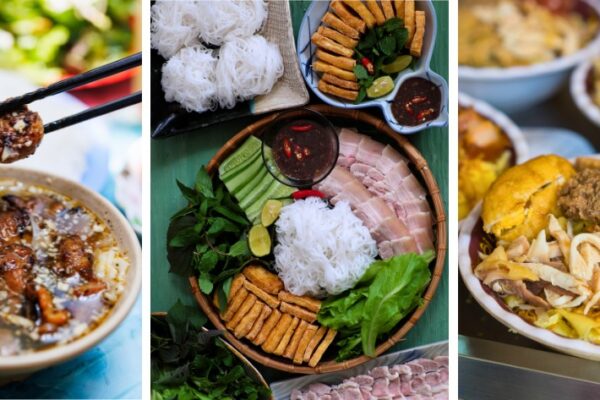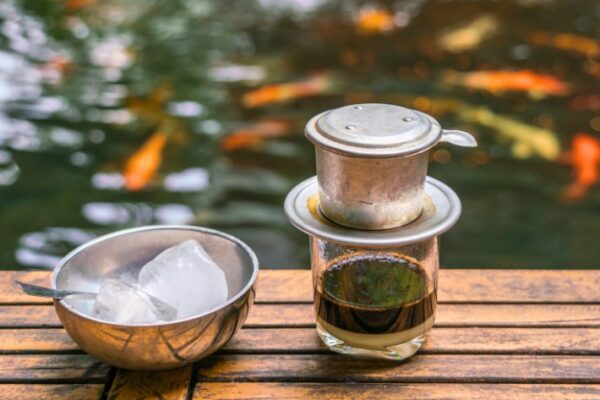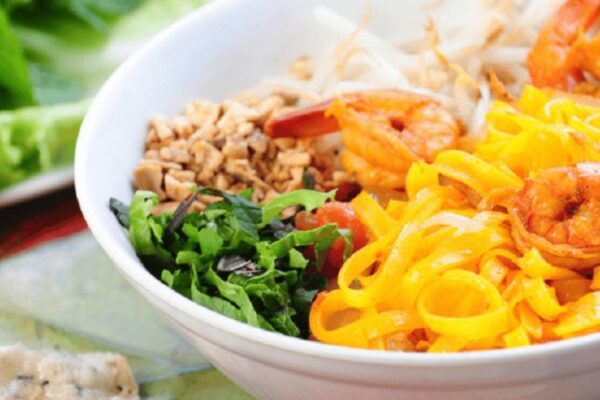Your Guide to the Top 10 Traditional Myanmar Dishes Every Traveler Must Try
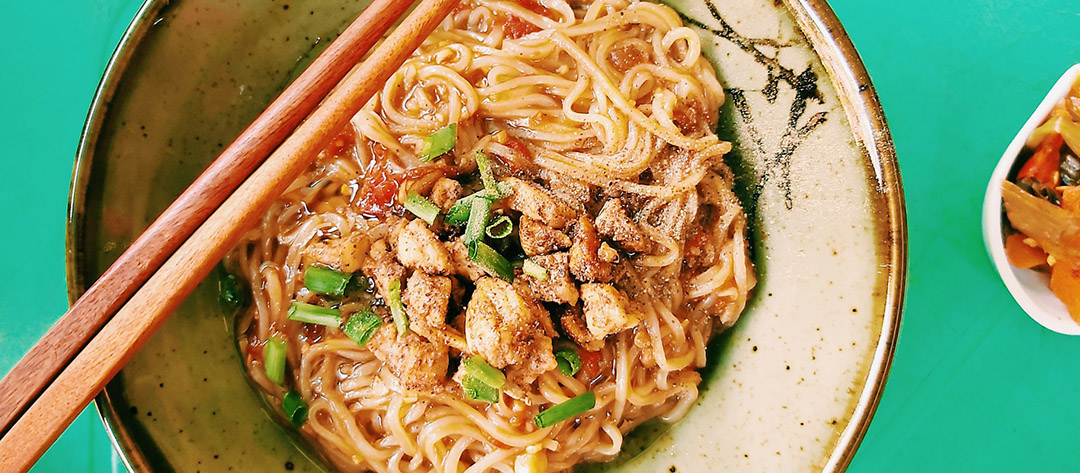
Myanmar, a land of ancient temples and breathtaking landscapes, offers a culinary scene as rich and diverse as its vibrant history. A melting pot of influences from its neighbors – India, China, and Thailand – yet fiercely independent in its flavors, Myanmar dishes are the delightful exploration of textures and tastes. Often characterized by a tantalizing balance of sour, spicy, salty, and savory flavors, the food of Myanmar is a sensory journey.
From the sizzling woks of urban street vendors to the comforting aromas of home-cooked meals, a world of unforgettable gastronomic experiences awaits the adventurous foodie.
This article is your comprehensive guide to the culinary pilgrimage that will introduce you to the heart and soul of this enchanting country, one delicious bite at a time. Prepare to expand your palate and discover why Myanmar is a true paradise for those who travel for food.
Mohinga: The Heart and Soul of Myanmar on a Spoon
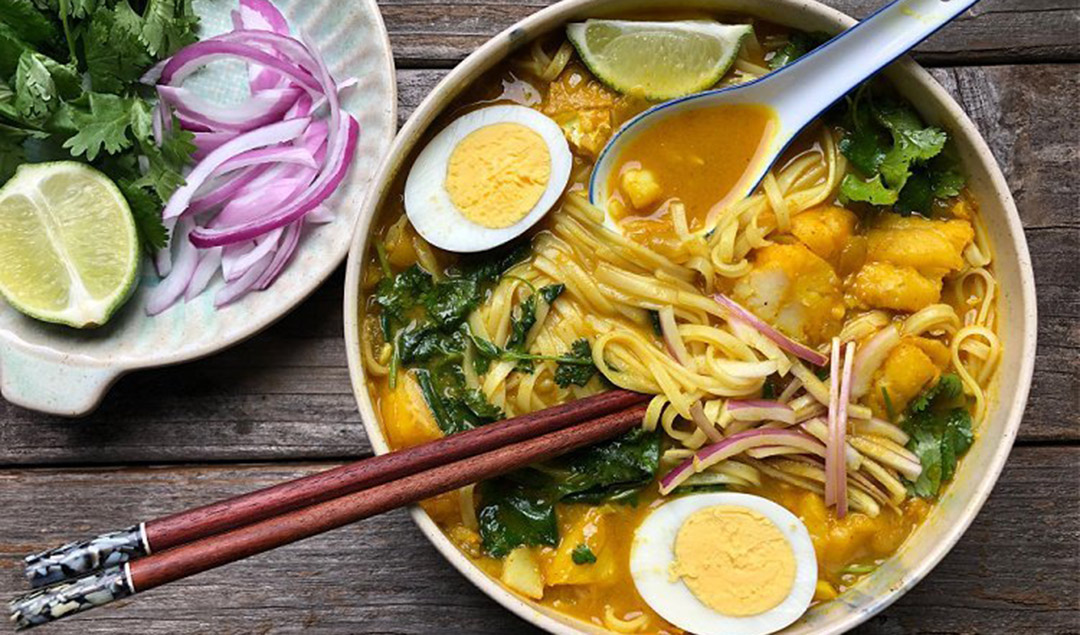
No culinary journey through Myanmar is complete without tasting Mohinga, a fish noodle soup that holds the title of Myanmar’s national dish. This beloved breakfast staple has transcended time, evolving from a humble rice-based broth to a cultural icon celebrated countrywide. Its warming, aromatic flavors are a testament to Myanmar’s riverine heartlands and communal traditions.
A Taste of Tradition
Mohinga’s roots stretch to ancient times, with early references found in the Pyu city-states (2nd century BCE to 11th century CE), where fish and rice formed the cornerstone of regional cuisine. By the time of the Konbaung Dynasty (1752–1885), it had solidified as a distinct dish, often sold by vendors to traveling communities.
Inside the Bowl
At its core, Mohinga is a fragrant fish broth, typically made with catfish or carp. The base is simmered for hours with lemongrass, ginger, garlic, and toasted rice powder (which thickens the soup and adds a nutty depth). Thin rice noodles and tender banana stem slices form the starchy, textured base.
The Perfect Toppings
A steaming bowl of Mohinga is a customizable feast. While regional variations exist, common additions include:
- Crunchy elements: Crispy fried onion fritters or fried lentils.
- Fresh herbs: Cilantro, mint, or basil for a bright flavor.
- Optional extras: Boiled eggs, chili flakes, lime wedges, or pickled rice bran for tang (note: these garnishes may vary regionally).
Where to Find It
Mohinga is ubiquitous in Myanmar, from bustling street stalls in Yangon to family-owned shops and upscale restaurants. For an authentic experience, seek out vendors at dawn markets or along riverfronts—most servings cost under 2,000 kyats (1–2 USD).
Lahpet Thoke: The Unique Salad Of Myanmar Dishes
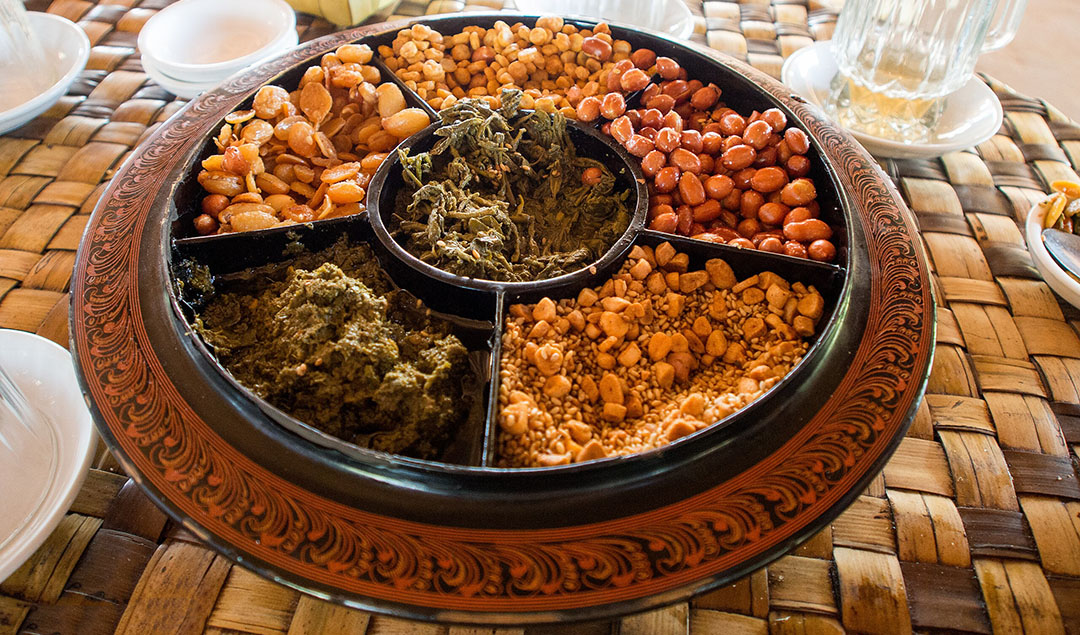
Prepare to have your definition of salad forever changed by Lahpet Thoke, Myanmar’s iconic fermented tea leaf salad. This dish is a testament to the country’s unique culinary creativity and holds a significant place in Burmese culture, historically served as a peace offering between warring kingdoms.
A Cultural Delicacy
The name Lahpet Thoke combines the Burmese words for “tea leaves” (lahpet) and “salad” (thoke). Unlike conventional green salads, this dish is rooted in fermented tea leaves (lahpet)—a process that dates back to pre-colonial Myanmar.
A Harmonious Mix of Flavors & Textures
A traditional Lahpet Thoke is a vibrant, balanced salad featuring:
- Base: Soft, earthy fermented tea leaves.
- Vegetables: Shredded cabbage, diced tomatoes, and crisp fried split peas (common in Burmese cuisine).
- Crunch: Roasted peanuts, crispy fried lentils, and fried garlic.
- Depth: Dried shrimp for brininess, chili flakes for heat, and fish sauce (or lime juice) for acidity.
- Optional Additions: Sesame seeds or fresh herbs (like mint) for texture and freshness.
A Dish for Every Occasion
Lahpet Thoke transcends categorizations:
- Snack: Served with toasted sesame crackers at tea shops.
- Appetizer: A crowd-pleaser at social gatherings.
- Main Course: Paired with rice or noodles for a filling meal.
- Cultural Symbol: Historically exchanged as a peace gesture between kingdoms; today, it signifies hospitality and communal sharing.
Where to Try It & Cost
You’ll find Lahpet Thoke nationwide, from street stalls to upscale restaurants. Prices vary, but most servings cost under 5,000 kyats (2–3 USD)—a modest price for a dish rich in history and flavor.
Shan Noodles: A Taste of the Mountains
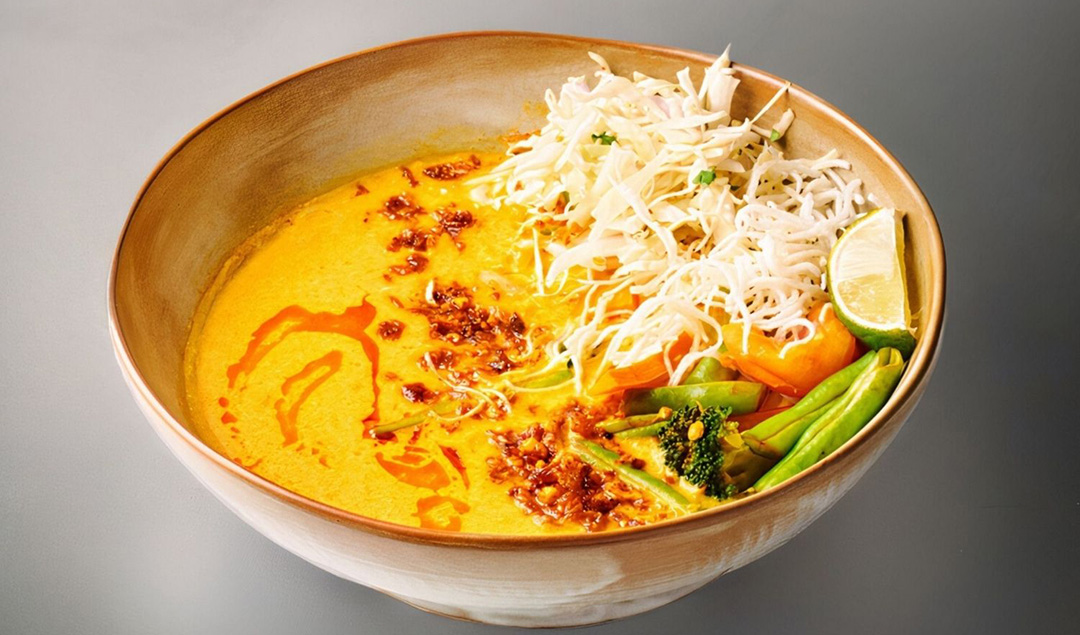
Hailing from Myanmar’s Shan State in the eastern highlands, Shan Noodles (also called Shan Khao Swe) are a beloved regional staple and a testament to the Shan people’s rich culinary tradition. Blending Burmese, Thai, and Chinese influences, this dish reflects the crossroads culture of Myanmar’s mountainous border regions.
Two Distinct Versions
Shan Noodles come in two forms:
- Soup: A light, broth-based dish with flat rice noodles, often flavored with tomato, soy sauce, and chili. The broth may include chicken or pork, and toppings like pickled mustard greens and fried garlic add brightness and crunch.
- Dry: Noodles coated in a thick, aromatic tomato-soy sauce, enriched with fermented soybean paste (pe pyoke). This version is drizzled with garlic oil, topped with crushed peanuts, fresh herbs (mint, cilantro), and crispy fried split peas for texture.
Key Ingredients
- Noodles: Chewy rice noodles, typically round or flat.
- Flavor Base: Tomato, soy sauce, and fermented soybean paste (adding umami).
- Common Toppings: Fried split peas, peanuts, herbs, pickled mustard greens, and chili flakes.
- Protein: Chicken or pork, simmered in the sauce or broth.
>> You might want to know: Bangkok Food Tour Meets City Culture – Explore Its History Through The Flavors
Where to Find Them
While Shan Noodles are found nationwide, their most authentic versions thrive in Shan State—especially in towns like Nyaungshwe (near Inle Lake). Restaurants specializing in Shan cuisine also abound in Yangon and Mandalay, often featuring regional variations. Expect to pay under 3,500 kyats (2–3 USD) for a hearty bowl.
Burmese Curry: A Rich and Oily Affair
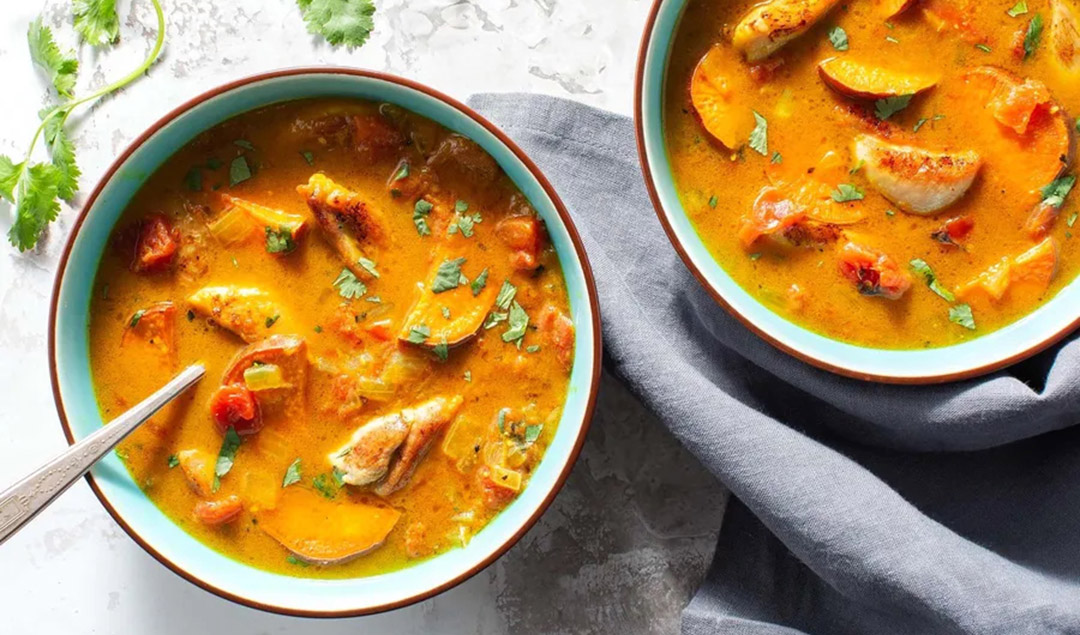
Burmese curries, known as hin, are a cornerstone of Myanmar dishes, balancing slow-cooked meats with aromatic spices and a distinctive oily richness. Unlike Thai coconut curries or Indian yogurt-based preparations, Burmese curries rely on hearty oil and bold flavors.
Key Characteristics
- Base Components: Most curries begin with onions, garlic, ginger, and turmeric—pounded into a fragrant paste and slowly sautéed until they darken.
- Oil Usage: Traditional recipes use generous amounts of oil (peanut, vegetable, or sesame), which separates into a golden layer on top when cooked properly—a sign of richness.
- Meat Selection: Common proteins include chicken (most popular), pork, fish, and occasionally beef or mutton. Fish sauce (ngapi yay) often enhances umami, especially in vegetarian curries like potato Aloo Hin.
A Meal Structure
A classic Burmese meal centers around a hearty curry, served with:
- Steamed rice: A neutral base to soak up flavors.
- Side dishes: A light soup, blanched vegetables (e.g., cabbage, bamboo shoots), and a tangy dip (ngapi yay with fresh herbs).
- Salads: Crisp Laphet Thoke (fermented tea leaf salad) or tomato-based Tofu Thoke.
Where to Eat Like Locals
For authenticity, visit family-run curry houses. These street-side eateries display daylong-simmered curries in clay pots or metal pans. Point to your preferred dish (such as chicken or pork) and ask for a rice plate with sides. Prices range from moderate to affordable (exact costs vary regionally).
Nan Gyi Thoke: The Spaghetti of Myanmar
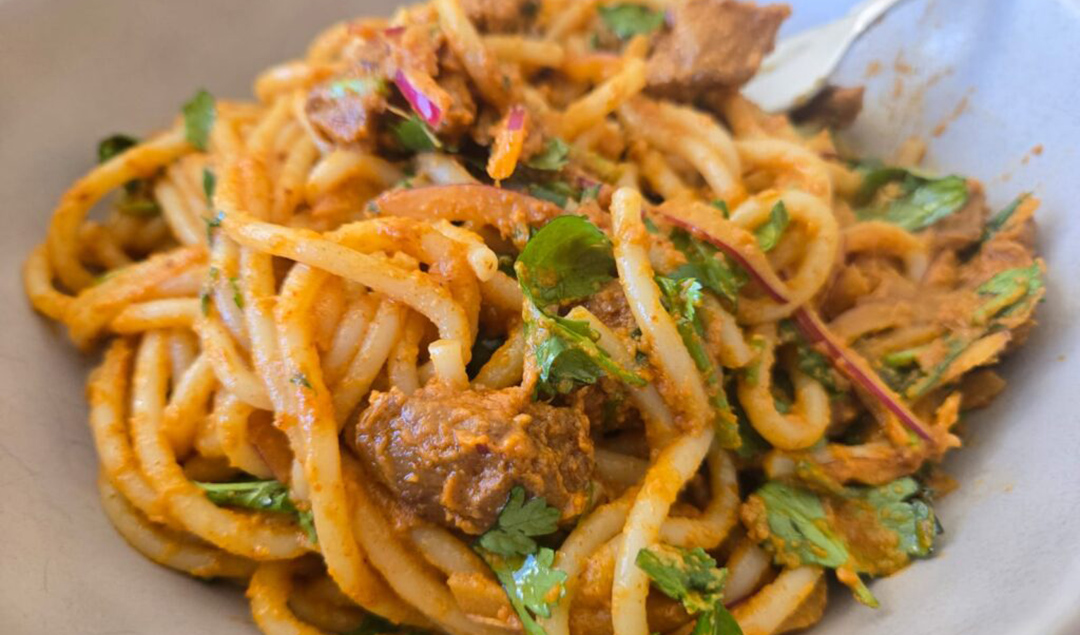
Dubbed the “Burmese spaghetti” for its thick, round rice noodles, Nan Gyi Thoke is a staple of breakfast and lunch throughout Myanmar. This vibrant salad combines bold flavors and contrasting textures, making it a must-try dish.
Core Components
Noodles: Thick, round rice noodles (similar to Vietnamese banh canh) form the base.
Sauce: A rich chicken curry gravy infused with turmeric, chili, fish sauce, and roasted chickpea flour (dhal powder), creating a nutty, savory dressing.
Toppings:
- Aromatic Crunch: Crispy fried garlic and toasted chickpeas.
- Freshness: Cucumber, red onion, cilantro, and a squeeze of lime.
- Protein: Boiled egg and chicken (optional; some versions use tofu for a vegetarian twist).
Cultural Significance
Nan Gyi Thoke is nationwide and particularly revered as a breakfast item. Unlike lighter salads, its hearty sauce and chewy noodles provide sustained energy for a day of exploration. Historically, this dish thrived in Mandalay’s bustling markets, but its popularity now spans the country.
Where to Try It
Seek out local eateries or street stalls, where servers will typically arrange the dish to your liking. Expect a filling portion under 3,000 kyats (1.50–3 USD), often served with a basic chicken soup or fresh cucumber for balance.
Samosa Thoke: A Crispy, Tangy Delight
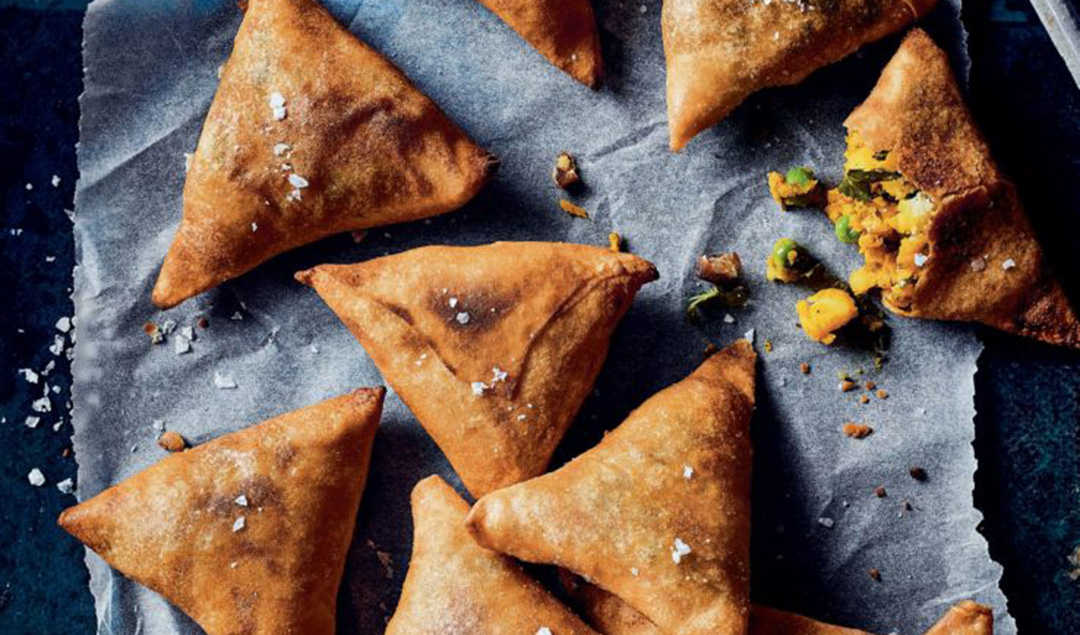
While samosas originated in Indian cuisine, their transformation into Samosa Thoke reflects the culinary creativity of Burmese cuisine. This dish typically features crispy samosas filled with spiced potatoes (not chickpeas), accompanied by onions, cilantro, and turmeric.
Construction and Ingredients
- Deconstructed Samosas: Crispy samosas are cut into bite-sized pieces and combined with shredded cabbage, thinly sliced onions, fresh mint, and coriander.
- Dressing: A tangy and savory sauce made with tamarind paste, lime juice, fish sauce, and minced garlic binds the salad. Chili powder or fresh chilies add heat, while lemon wedges and fresh herbs garnish the dish.
Street Food Popularity
Samosa Thoke thrives as street food across Myanmar, particularly in cities like Yangon. Vendors serve it as an affordable afternoon or evening snack, often with optional additions like lentils or falafel. While prices are low, exact costs (e.g., “under $1”) vary by location and portion size.
Mont Lin Mayar: A Snack for a “Couple”
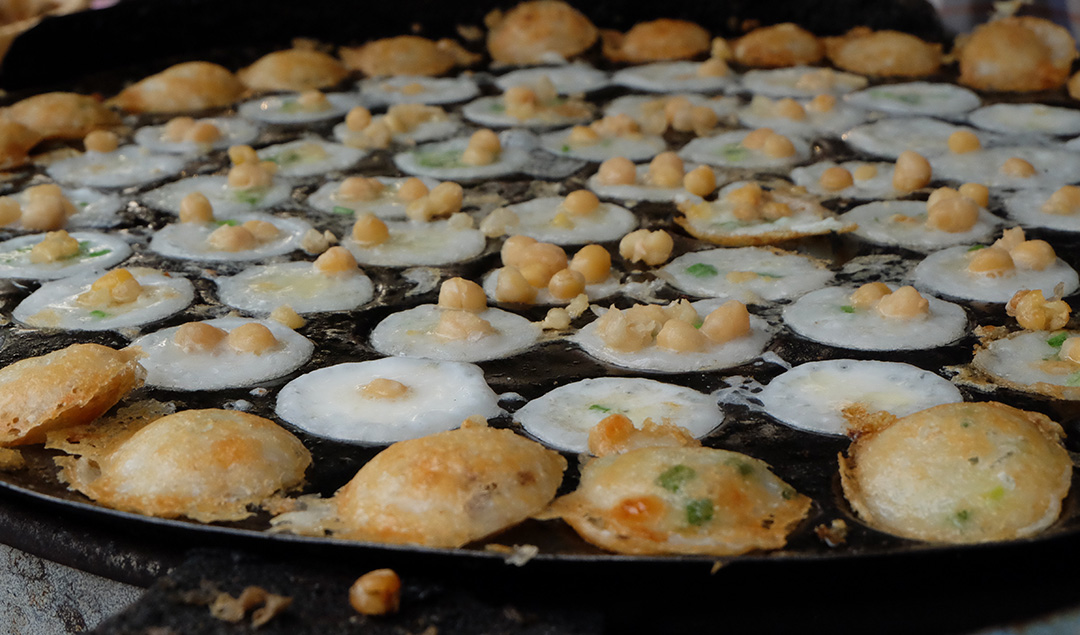
This iconic Burmese snack, literally meaning “husband-and-wife snack,” reflects its preparation method. Two small rice flour batter halves are fused together, symbolizing unity, and commonly served as a single round treat.
Ingredients & Preparation
- Batter: Made from rice flour, water, and sometimes coconut milk or ginger, it’s cooked in a cast-iron griddle with hemispherical molds.
- Fillings: Common toppings include quail eggs, yellow split peas (not chickpeas), scallions, or tomatoes. Modern variations may add minced chilies or freshwater fish.
Cooking Process
Vendors skillfully pour batter into molds, add toppings to one half, and seal with the other half, creating a crispy exterior and soft interior. The efficiency and artistry involved in flipping the halves make the preparation highly theatrical.
Availability & Cost
Mont Lin Mayar is sold by street vendors, especially in the mornings or evenings near markets and busy intersections. Prices are incredibly low (often <$1 for several pieces), making it a budget-friendly snack.
Cultural Role
While often enjoyed as a quick bite, it’s also a popular social snack, shared during tea breaks or casual gatherings. Its lasting appeal lies in its simplicity, versatility, and connection to Burmese culinary traditions.
Shan Tofu: Not Your Average Tofu
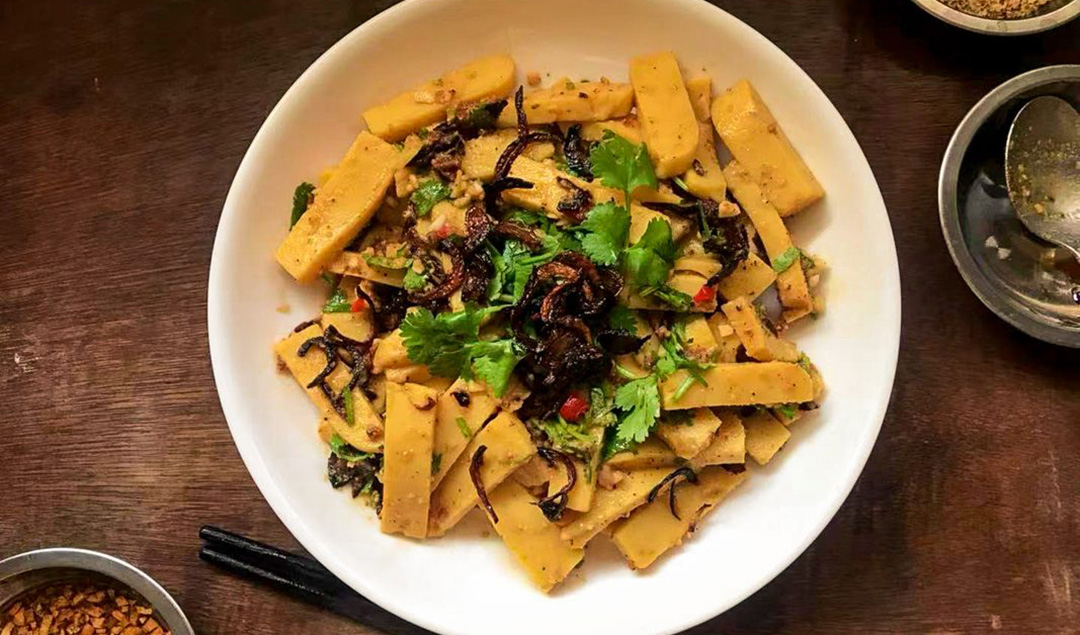
Shan Tofu (Tohu) is a Burma’s Shan State specialty, deriving its name from the Shan people. Unlike traditional soybean tofu, it’s crafted from chickpea flour (besan), water, and salt, yielding a firm, custard-like texture.
Preparation & Texture
The tofu is prepared by cooking a batter of chickpea flour and water until thickened, then setting it into a sliceable block. It’s not a creamy porridge but a semisolid cube with a mild nutty flavor.
Serving Styles
- In curries, sliced or cubed tofu is added to spicy, tomato-based curries with onions, garlic, and spices, often making them vegetarian.
- With Dipping Sauces: Paired with fresh chutneys like a garlic-ginger-chilli sauce or soy-ginger combinations.
- Garnishes: Crushed peanuts, cilantro, and chili flakes are common toppings for added crunch and heat.
Vegetarian-Friendly
While tofu itself is plant-based, some restaurants may serve it with meat-based broths. Asking for a vegetarian version ensures compliance with dietary preferences.
Regional Availability
Shan Tofu is best experienced in Shan State, though it’s widely available in Yangon and Mandalay at Shan restaurants. Prices typically range from $2-4 USD, depending on portion size and accompaniments.
Ohn No Khauk Swe: A Creamy Coconut Dream
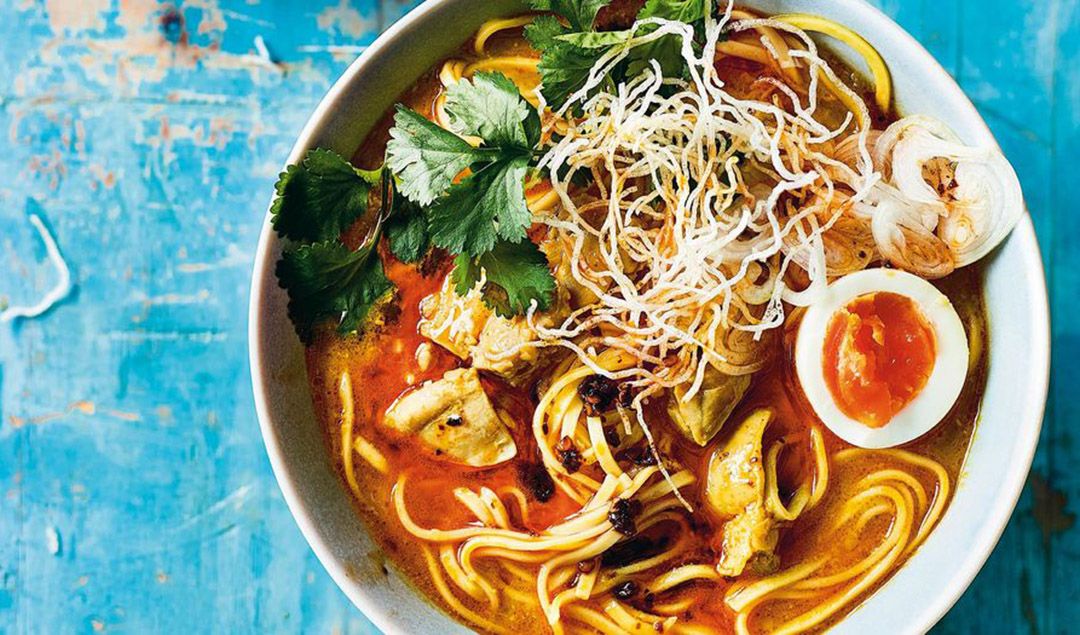
This Burmese comfort food centers on a flavorful coconut milk-based broth thickened with chickpea flour, creating a silky texture. Unlike other Southeast Asian laksa variations, it uses egg or rice noodles instead of wheat noodles.
Aromatic Broth
The golden-hued broth is seasoned with turmeric, ginger, garlic, and spices, often combined with chicken thighs, stock, or fish sauce. Coconut milk adds creaminess without overpowering the dish’s balance of sweet, savory, and slightly spicy notes.
Toppings & Garnishes
Served with a variety of add-ons:
- Hard-boiled eggs and crispy fried noodles for texture contrast.
- Sliced onions, cilantro, and a squeeze of lime for freshness.
- Optional chili flakes or oil for heat.
Cultural Context
It’s widely available in tea shops and markets across Myanmar. While prices vary, a typical bowl ranges from $2-4 USD (expected range; exact cost may differ by location).
Burmese Sweets (Mont): A Traditional Sweet Dessert
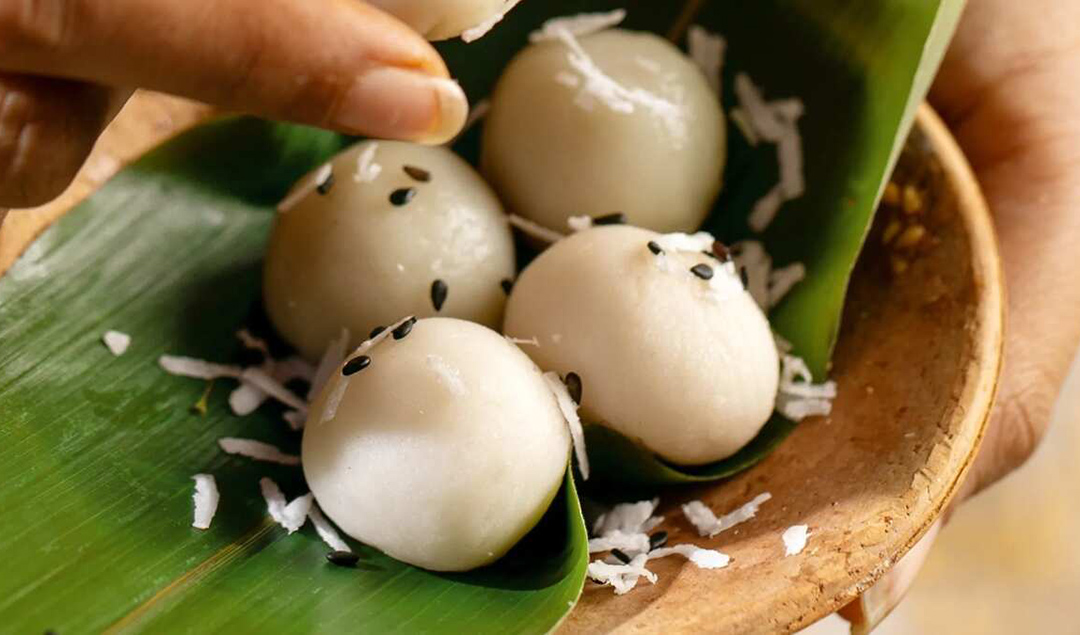
Burmese mont are sweet snacks enjoyed throughout the day, often paired with tea. Unlike Western desserts, they emphasize comfort and simplicity, rooted in local ingredients like glutinous rice, coconut, and palm sugar.
Core Ingredients
Mont typically combines:
- Glutinous rice for chewy textures.
- Coconut (shredded, milk, or cream) for creaminess.
- Palm sugar or brown sugar for sweetness.
- Tapioca/sago for tapioca-based desserts like Moh Let Saung.
Exceptions: Semolina cakes, while present (e.g., Shwegyi Sanwei Makin), are less traditional and use durum wheat flour.
Must-Try Traditional Mont
- Mont Lone Yay Paw: Boiled glutinous rice balls stuffed with palm jaggery, garnished with coconut shavings. Often enjoyed during festivals like Thingyan.
- Hsi Htamin (Glutinous Rice Cake): Infused with turmeric, onions, and coconut oil. Served with fried garnishes (e.g., onions, coconut) and optional fried chicken or fish.
- Htoe Mont: Sticky rice cakes cooked with raisins, cashews, and coconut shavings. Prodded during cooking to create a speckled texture.
- Moh Let Saung: A chilled dessert with sago pearls, palm sugar syrup, and coconut milk ice.
Sampling & Costs
Mont is inexpensive and widely available at markets or dedicated shops. While pricing isn’t explicitly detailed in sources, street snacks in Myanmar typically cost <$1–2 for portions, allowing visitors to sample multiple varieties.
>> You might love: Vietnam Food Tour -Comprehensive Guide to Culinary Delights
Final Thoughts
Myanmar dishes are the perfect blend of influences from neighboring Thailand, China, and India, yet it remains uniquely its own. Pair these culinary experiences with visits to stunning pagodas, serene lakes, and bustling markets to create the trip of a lifetime.
At Asia Pioneer Travel, our local expertise ensures you’ll not only taste Myanmar but truly experience it. Get in touch today to begin your personalized culinary journey!
